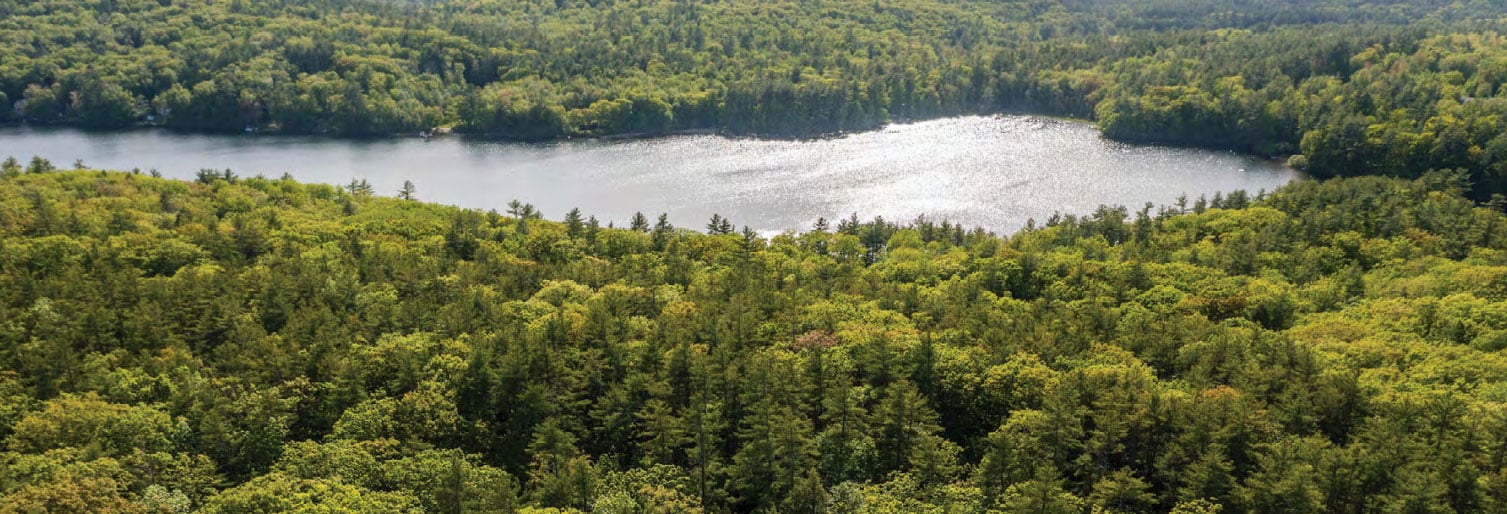Written by David Johnson
Photographed by Jerry Monkman and David Johnson
The conservation of the Landry property in Barrington has protected the waters of Nippo Lake – and the memories that have been created for generations.
The driveway to Jim and Joan Landry’s home is a winding ascent, the sort of climb that makes one appreciate the horsepower required to plow it during the winter. But any flatlanders prone to casting aspersions on way-above-sea-level-living would catch their breath upon seeing the Landrys’ view: a sprawling panorama that encompasses Mount Misery in the foreground, and acres of unspoiled terrain that unspool to the horizon.
Yeah, this is worth the driveway.
Not seen in this epic view, but arguably the most important natural feature that anchors it, is Nippo Lake, a true hidden gem of Barrington (and, frankly, all of New Hampshire). It is a place that holds significant sentimental value for the many people that grew up on its shores. Jim Landry, a Barrington life-long resident, is one of those people.
“This is a land that is very important to our family,” Jim says. “For the past fifty years, we’ve hiked and explored this place. My children played all around Mount Misery. We camped overnight all the time.”
These memories have been hewn throughout the 163 acres of the Landry’s property, and are the driving force behind their decision to work with SELT and the Nippo Lake Association to conserve their property and protect it for all time.
“You’re never going to stop building because the population will grow,” Jim says. “That’s why it’s important to protect this kind of land. The town is growing so fast you won’t find many pieces like this. I don’t think there are many properties like this, especially on a lake like this, that are very important to conservation.”
For all of its scenic – and emotional – significance, the Landry property’s natural resource ledger is over-stuffed: critical watershed protection for Nippo Lake, diverse wildlife habitat, and a vast network of high-ecological-value wetlands.
Water quality is of particular importance, as Nippo Lake – once a pristine water body that you could see through straight to the bottom – has been menaced by a large amount of phosphorus. In 2010, this resulted in a cyanobacteria bloom which fed on the abundance of nutrients present in the water. The bloom would become an annual recurrence over the ten years to follow, jarring the residents who lived on the lake.
In the years since the first appearance of the cyanobacteria bloom, a team of Nippo Lake Association volunteers,
outside experts, and New Hampshire Department of Environmental Services (NHDES) professionals worked together to develop strategies to combat this bacterial fouling of the once-flawless waters.
“In our childhood memories, this was a pristine little pond,” says Kevin Fitzgerald, a former Board member of the Nippo Lake Association, whose family has lived on the lake for over 50 years. Kevin helped spear-head much of the research and awareness of the lake’s ecological challenges. “The Lake Association is dedicated to the single purpose of the stewardship, care, and protection of Nippo Lake and its watershed. We are hoping to reverse some of the effects of the development. Over the passing of time, Nippo Lake has taken a pounding from man and nature.”
On November 20, 2023, the Landry property was protected forever and instantly became a critical arrow in the region’s conservation quiver. The land contains nearly 2,300 feet of frontage on Nippo Lake and the property, as a whole, makes up a whopping 25 percent of the lake’s watershed.
Nippo Lake drains to the Isinglass River, which is a Designated River under the NH Rivers Management and Protection Program (recognized for its outstanding natural and cultural resources) and the largest undammed tributary to Great Bay. Also of note, the property is part of a NHDES designated Outstanding Resource Watershed.
“You’re looking at a single piece of property that represents a quarter of the watershed that affects Nippo Lake and feeds it with water,” Kevin says. “The parcel is unique because it is so large, and influential because of its elevation, topography, and length of its connection to the lake.”
Watershed protection is far from the only conservation box the Landry property checks; it is packed with ecological and water resource diversity, including critical upland wetland habitats, a threatened forest system, three vernal pools, and two rare peatland communities (surface systems that are rich with peat soil and are major-league climate defenders, able to store twice as much carbon as forests).
"It is this magical bowl that sits between the rolling hills and small mountains of Barrington."
On the wildlife side of things, thanks to its lengthy, undisturbed shoreline, the Landry property is a valuable habitat for threatened common loons and bald eagles. Over 10 percent of the property is designated as Highest Ranked Habitat in New Hampshire and 132 acres (81%) is ranked as supporting landscape by the State of NH’s Wildlife Action Plan.
“The Landry forest is a critical piece of the mosaic of wildlands in Barrington,” said Doug Bogen, Chair of the Barrington Conservation Commission. “Its conservation protects much of the shore of the fragile Nippo Lake as well as historic and diverse open space in a relatively untouched portion of our town.”
“It’s a unique little place,” Kevin says. “Most people have heard of Lake Winnipesaukee or Squam Lake. But when
you talk about that quintessential New England lake, the kind that appears on the cover of an LL Bean catalog, it’s Nippo. It is this magical bowl that sits between the rolling hills and small mountains of Barrington.”


